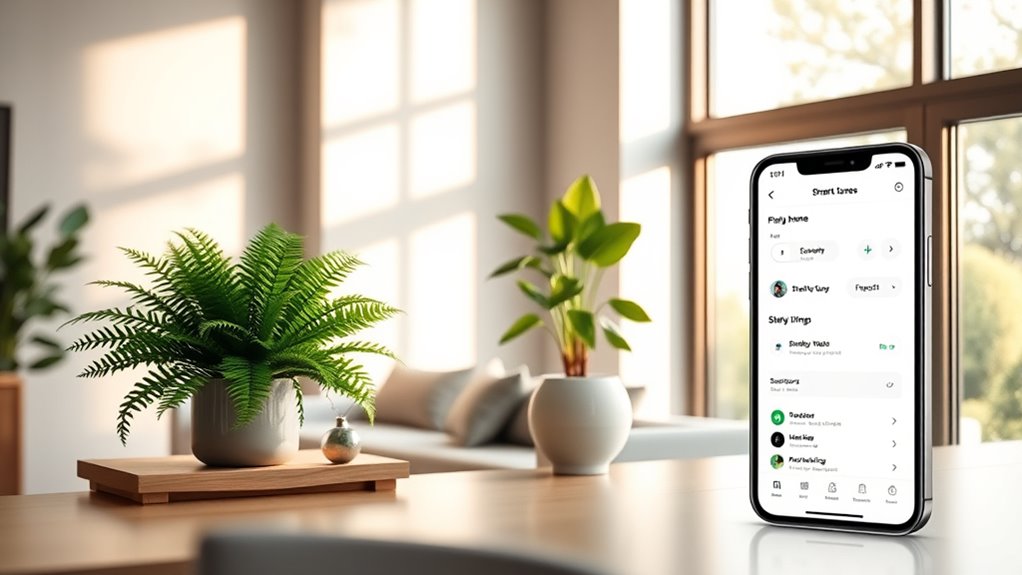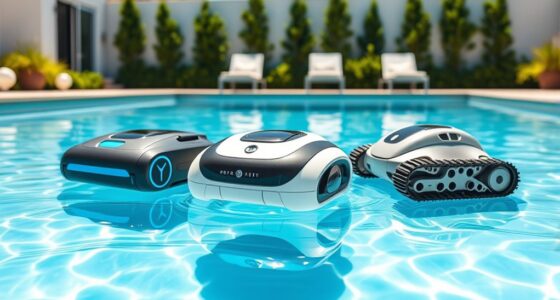To set up smart home automations for plant care, start by choosing compatible soil moisture sensors, climate monitors, and smart lighting. Connect these devices through platforms like Home Assistant or Google Home, and link them to smart plugs for watering, heating, and lighting. Create automations that trigger watering when soil gets dry, adjust lights based on plant needs, and send notifications for maintenance. Keep exploring to learn how integrating diverse devices streamlines your indoor garden management.
Key Takeaways
- Integrate soil moisture sensors and environmental monitors with your smart home platform for real-time data tracking.
- Automate watering, lighting, and climate control via smart plugs, switches, and connected sensors based on sensor thresholds.
- Use platform integrations like Home Assistant or Google Home to unify device management and create custom automation routines.
- Set up notifications and reminders for maintenance tasks such as watering, fertilizing, or inspecting plants.
- Incorporate remote monitoring tools like cameras and sensor dashboards for continuous oversight and adjustments.
Choosing the Right Smart Devices for Your Indoor Garden
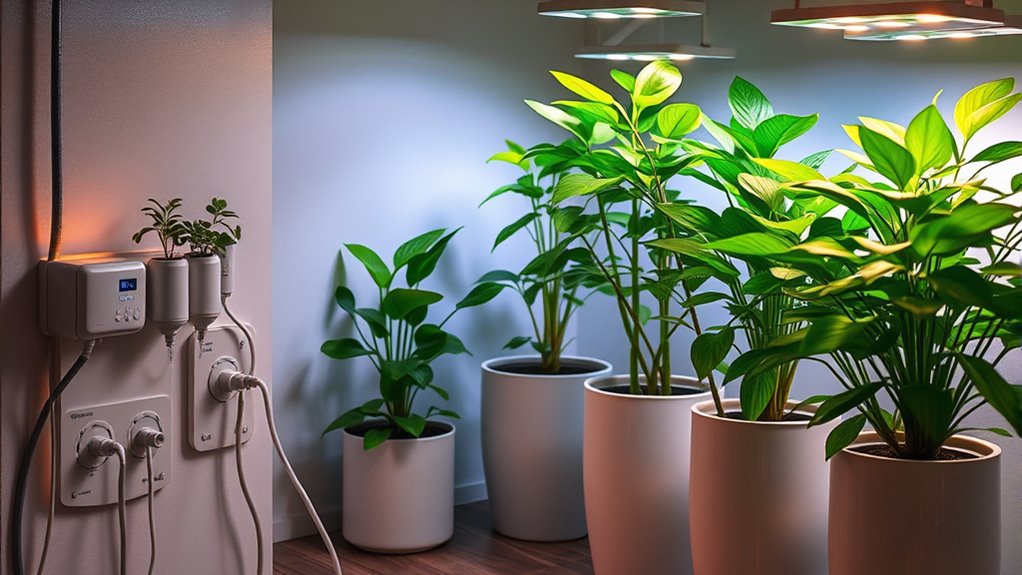
To create a successful smart indoor garden, choosing the right devices is essential. Start by selecting smart devices that support soil moisture sensors, like drip irrigation kits with adjustable emitters, to provide precise watering. Incorporating sensor accuracy ensures your system responds correctly to plant needs, promoting healthier growth. Invest in smart sensors such as EarthOne Smart Plant Monitors or Meross devices, which track temperature, humidity, light, and soil moisture, giving you a thorough view of your indoor garden’s health. Pair these sensors with compatible smart plugs or switches to control grow lights, heaters, and fans, enabling automation based on sensor data. Look for devices that integrate seamlessly with platforms like IFTTT, Home Assistant, or Google Home for smooth smart home automation. Prioritize connectivity options, battery life, and easy installation to optimize your plant care setup. Including proper device integration can help ensure your system functions reliably and simplifies managing your plants. Additionally, selecting devices with reliable connectivity can prevent disruptions in your automation routines. Regular updates and firmware checks also help maintain device performance over time. Moreover, choosing devices with energy efficiency can reduce power consumption and lower operating costs.
Automating Watering With Soil Moisture Sensors
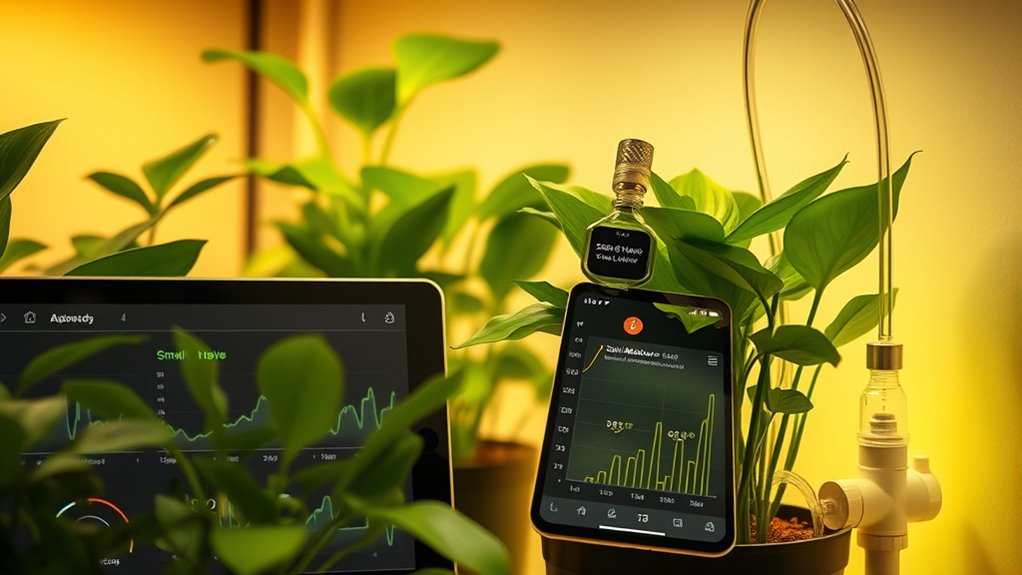
Automating watering with soil moisture sensors streamlines your indoor gardening routine by ensuring plants receive the right amount of water at the right time. Soil moisture sensors detect the water content in soil and send real-time data to your smart home system.
When moisture levels fall below a preset threshold, automation triggers a smart watering system to activate, maintaining ideal soil hydration. Proper placement of sensors near plant roots guarantees accurate readings, leading to more effective watering decisions. Regular calibration of these sensors helps prevent over- or under-watering, supporting healthy plant growth. Additionally, understanding cookie usage and integrating your sensors with automation platforms like IFTTT can help you create a tailored watering schedule that responds automatically to your plants’ needs, making plant care more efficient and less hands-on. Leveraging AI technology can further enhance the accuracy of your automation setup by analyzing environmental data for optimal watering times. Incorporating air quality data can also inform watering decisions, especially in indoor environments where humidity levels impact plant health. Considering plant-specific requirements ensures that each type of plant receives personalized care based on its unique water needs. Implementing plant health monitoring tools can provide additional insights into your plants’ overall well-being, leading to more precise watering strategies.
Managing Climate: Heating and Humidity Control
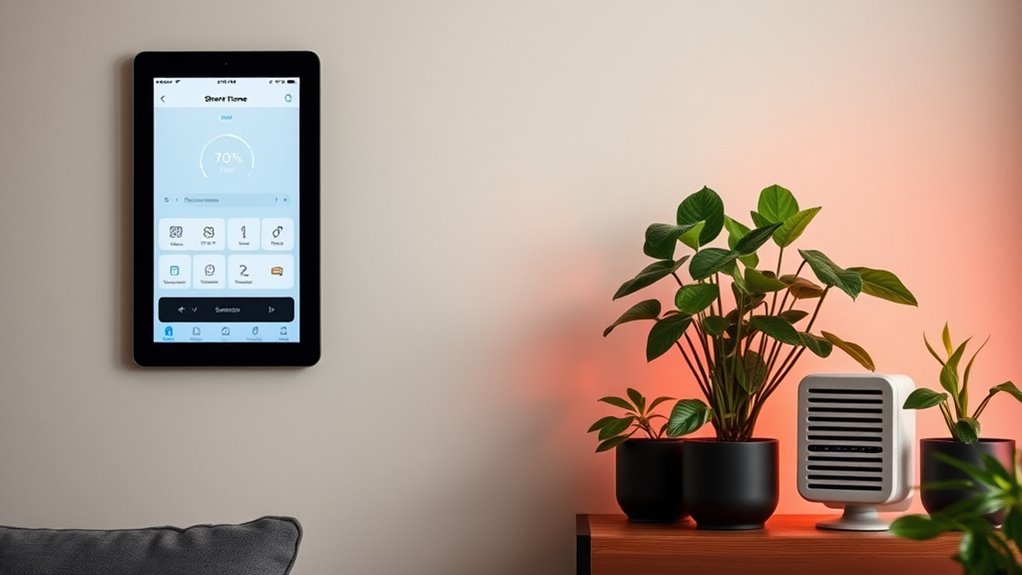
Managing climate conditions in your smart home garden involves controlling heating and humidity levels to keep plants healthy. Proper climate control prevents stress from temperature fluctuations and dryness. Use smart sensors to monitor temperature and humidity, triggering automations that activate heating or humidifiers when needed. This proactive approach helps maintain consistent conditions and energy efficiency. To implement this effectively: 1. Place smart sensors near plants for accurate readings. 2. Connect smart heat mats or heaters to smart plugs for automated control. 3. Program automations to turn on heating when temperature drops below 65°F (18°C). 4. Automate humidifiers or misting systems based on humidity levels. Additionally, selecting the right sensors with accurate filtration systems ensures reliable readings and optimal plant care. Incorporating privacy considerations when setting up sensors and automations helps protect your data and maintain security. Considering sensor calibration can further enhance the precision of climate control, ensuring your plants receive the best environment. Regular maintenance of your sensors and devices also contributes to sound system accuracy and longevity. Implementing data privacy measures can help safeguard your personal information in smart automation setups. With these automations, your climate control system maintains ideal conditions, promoting healthy plant growth without manual intervention.
Enhancing Growth With Automated Lighting Systems
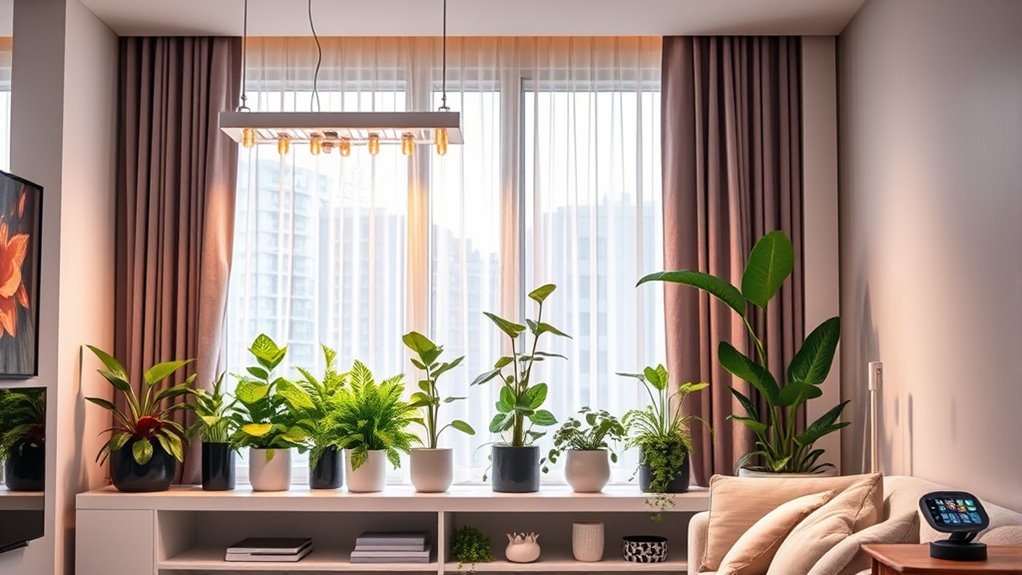
Have you ever wondered how to maximize your indoor garden’s light conditions for healthier, faster plant growth? Automated lighting makes this easy by using smart grow lights that adjust brightness and duration based on your plants’ needs.
With a proper light schedule, typically 6 to 10 hours daily, you ensure consistent exposure for ideal photosynthesis. Incorporating ambient light monitoring allows your system to automatically increase or decrease artificial light, maintaining the perfect environment. Additionally, venting requirements should be considered to ensure proper airflow and prevent heat buildup around your lighting setup. Proper lighting control systems can further enhance efficiency and plant health.
Pre-set lighting schedules aligned with sunrise and sunset automate the cycle, reducing manual adjustments. Data-driven lighting controls tailored to your plant’s specific requirements can drastically boost growth rates and overall health. Using intelligent systems can further optimize your plant care by adapting to changing conditions and providing real-time feedback. Integrating essential oil safety principles can also help maintain a healthy environment by preventing mold or pests that thrive in humid conditions created by heating and lighting systems. Incorporating Gold IRA strategies into your investment portfolio highlights the importance of diversification and smart management, which can be applied to your plant care automation systems to optimize performance and longevity.
Incorporating Reminders and Notifications for Plant Care
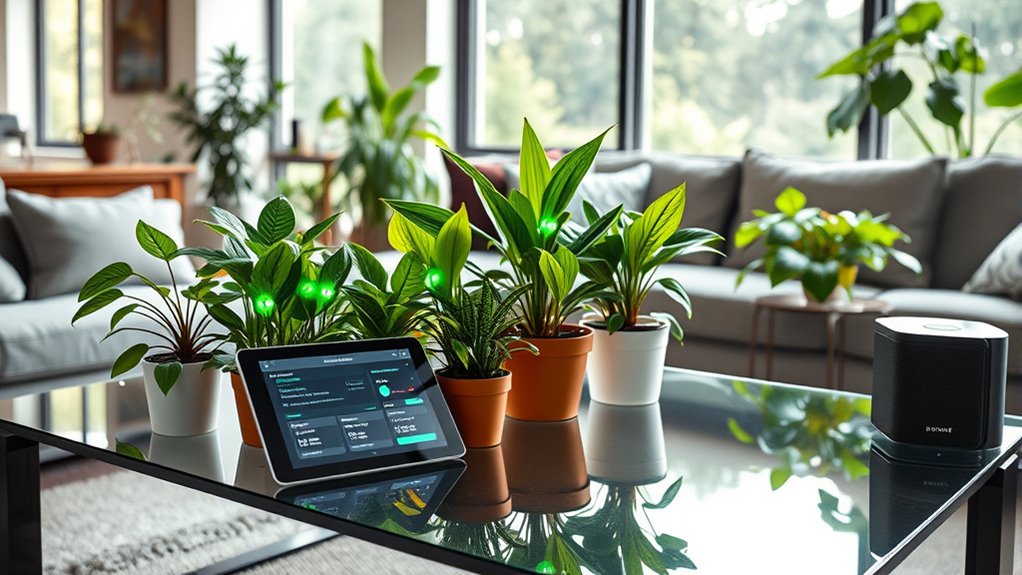
Incorporating reminders and notifications into your smart home setup guarantees you never forget essential plant care tasks. With smart home devices, you can receive alerts for specific needs, like soil moisture levels or maintenance reminders. These notifications help you stay proactive and ensure your plants thrive. Utilizing beginners guides can provide helpful tips on setting up effective automation routines and understanding plant needs better. Here are some ideas to get started:
- Set scheduled reminders for watering or fertilizing every few days.
- Use sensors to trigger notifications when soil moisture drops below a certain point, which can be enhanced by understanding sensor technology to optimize placement and accuracy.
- Enable alerts for environmental changes, like temperature or humidity deviations, which are crucial for maintaining optimal plant conditions. Incorporating smart sensors can significantly improve your ability to monitor these parameters remotely.
- Create custom notifications for tasks such as recharging reservoirs or adjusting grow lights. Additionally, understanding pollution and hydrogen fuel cells can inspire sustainability-focused automation, like monitoring energy consumption or integrating renewable energy sources for your smart system. Moreover, integrating data on eco-friendly materials used in planters can help promote sustainable gardening practices within your automation routines.
Monitoring Plants Remotely Using Cameras and Sensors
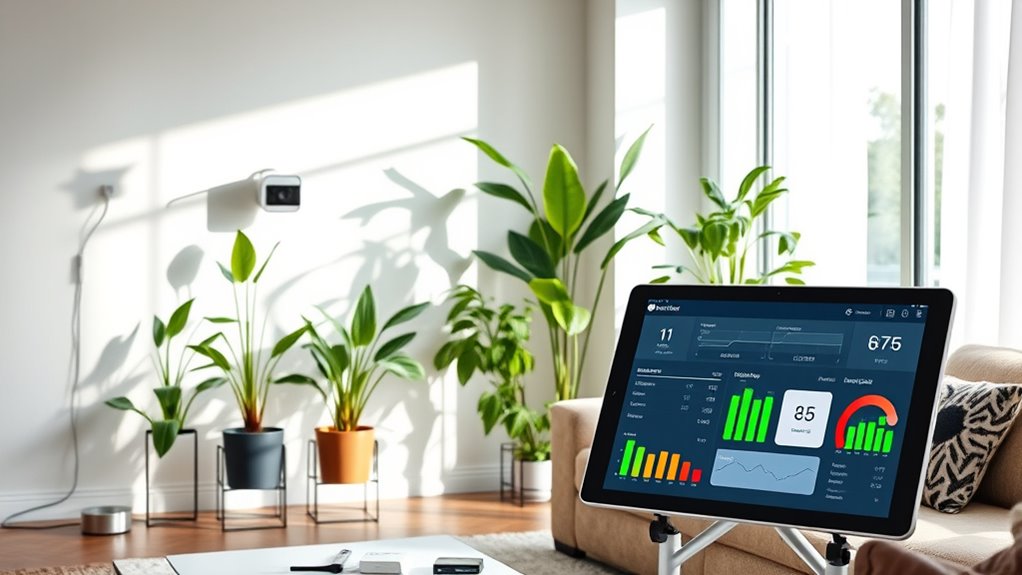
Using cameras and sensors, you can monitor your plants remotely with ease, ensuring they receive proper care without being physically present. Place soil moisture, temperature, and light sensors near your plants to gather real-time data accessible through smart home systems like Home Assistant. Connect inexpensive cameras with zoom features, such as Blink, to view live footage anytime. Regularly review footage and sensor readings to assess hydration, growth, and environmental conditions. This setup allows you to make informed decisions about watering, smart lighting, and other care routines remotely. Here’s a quick overview:
| Device Type | Monitoring Focus | Integration Point |
|---|---|---|
| Camera | Visual plant health | Live feeds & recordings |
| Soil Moisture Sensor | Watering needs | Automated alerts |
| Temperature Sensor | Climate control | Smart home dashboards |
| Light Sensor | Light levels | Lighting adjustments |
| Automation System | All data points | Central control |
Integrating Smart Home Platforms for Seamless Control
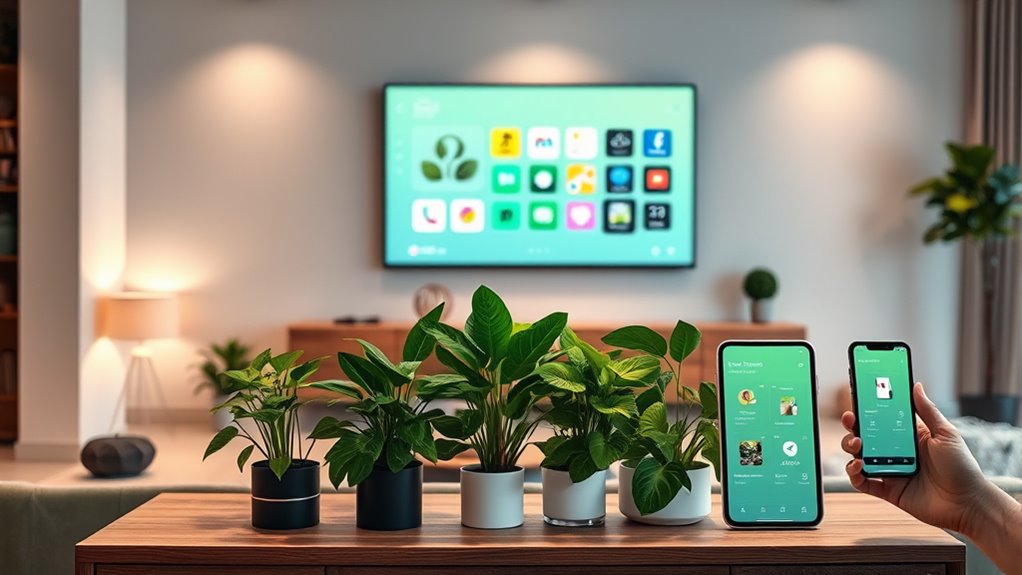
To manage your plant care devices smoothly, you need compatible automation ecosystems like Home Assistant, Apple HomeKit, or Google Home.
Connecting devices through central management guarantees control and ensures everything works together reliably.
Exploring cross-platform methods and proper setup steps helps you automate watering, lighting, and climate adjustments seamlessly.
Compatible Automation Ecosystems
Integrating smart home platforms like Home Assistant, SmartThings, or Apple HomeKit allows you to control your plant automation devices from a central hub, making the process more efficient and user-friendly. A compatible ecosystem uses common protocols such as Zigbee, Z-Wave, or Wi-Fi to connect sensors, lights, and watering systems seamlessly.
Using automation hubs or bridges like Hubitat or Aqara Hub guarantees diverse device brands communicate within one system. Many ecosystems also support IFTTT or native tools to create complex routines for plant care.
Additionally, compatibility with voice assistants like Alexa, Google Assistant, or Siri enables hands-free management of your automation devices. This setup enhances your smart home ecosystem’s flexibility, ensuring smooth operation and easy control of all your plant care devices.
Centralized Device Management
Connecting your plant care devices to a smart home platform like Home Assistant, Alexa, or Google Home allows you to manage everything from a single interface. This centralized control simplifies your automation system, making it easier to coordinate device integration across your smart home ecosystem.
With everything connected, you can remotely manage watering, lighting, and sensors through one app or voice command, enhancing convenience. Centralized device management enables you to set automation rules that trigger actions across multiple devices, like activating a heater when sensors detect cold conditions.
Using standard protocols such as Z-Wave, Zigbee, or Wi-Fi guarantees smooth interoperability within your setup. This unified approach streamlines your plant care routines, giving you full oversight and control from anywhere.
Cross-Platform Integration Methods
Achieving seamless control over your smart plant care devices often involves bridging different platforms and ecosystems. Cross-platform integration enables devices from ecosystems like Alexa, HomeKit, and Google Home to communicate and be controlled centrally.
To do this effectively, you can:
- Use platforms like Home Assistant or Hubitat to create automation routines that span multiple ecosystems.
- Implement protocols such as MQTT, Zigbee, or Z-Wave to ensure interoperability between devices from different brands.
- Use cloud services like IFTTT or Stringify as bridges for devices that don’t natively connect.
- Configure device APIs, authentication, and automation logic carefully for reliable, secure, and synchronized plant care routines.
This approach expands your smart home technology’s capabilities, making plant care more efficient and effortless.
Frequently Asked Questions
Is There an App to Help Take Care of Plants?
You’re asking if there’s an app that can help you take care of your plants. Yes, many apps like Planty, GrowIt!, and SmartPlant offer features like watering reminders, growth tracking, and plant identification.
They often connect with smart home devices to automate watering and lighting. These apps give you personalized care schedules and send notifications, making plant care easier and more consistent, whether you’re a beginner or experienced gardener.
What Is a Smart Plant Care System?
A smart plant care system uses connected devices and sensors to automatically manage your indoor plants. You get real-time data on soil moisture, temperature, humidity, and light, helping prevent overwatering or underwatering.
It integrates with platforms like Alexa or Google Home, so you can control and customize your plant care routines remotely. These systems include automated watering, grow lights, and environmental sensors that keep your plants healthy effortlessly.
What Is the PLT 1 Ultimate Plant Sensor for Home Assistant?
Think of the PLT 1 Ultimate Plant Sensor as your plant’s silent guardian. It’s a Bluetooth Low Energy device that monitors soil moisture, temperature, light, and conductivity, providing real-time data for your Home Assistant setup.
You can easily connect it via Bluetooth, see its info on your dashboard, and automate watering or lighting. With this sensor, you turn your home into a nurturing environment, ensuring your plants thrive effortlessly.
How Much Is Plant Care App?
You’re wondering about the cost of plant care apps. Prices vary from free options with basic features to premium subscriptions costing $10 to $15 per month.
Free apps like Planty or GrowIt! offer watering reminders and plant info.
While paid versions provide advanced automation and personalized alerts.
Annual subscriptions typically range from $20 to $50, depending on the level of automation and smart home integrations you want to add.
Conclusion
With smart systems seamlessly syncing, you’ll savor the satisfaction of a thriving, stress-free indoor garden. By blending brilliance with balance, you’ll build a beautiful haven where plants flourish effortlessly. Embrace the ease of automated watering, lighting, and monitoring, turning your space into a sanctuary of serenity and success. Let technology transform your plant care routine into a delightful dance of dedication and discovery, delivering daily joy and lush, lively leaves.
